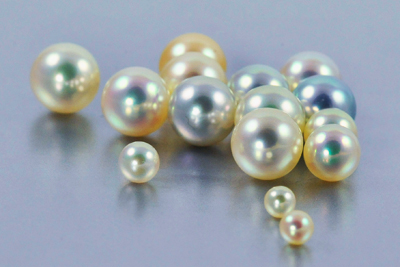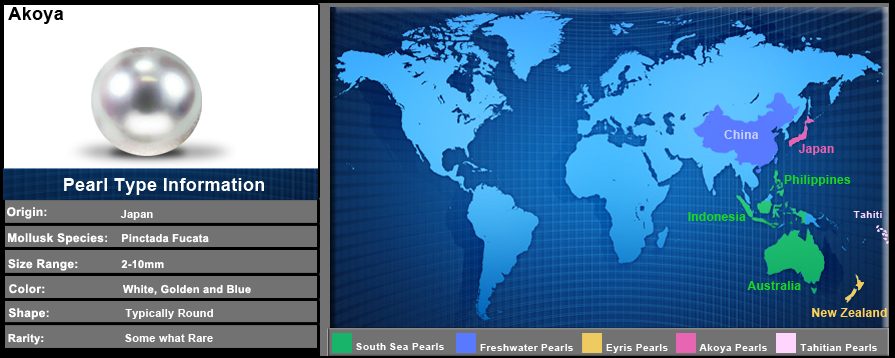The Akoya Pearl is the Classic Pearl.
Prized for there mirror like luster Akoya pearls have been considered the traditional and classic cultured pearl for over a century. The Akoya pearl is born from an oyster known as the Pinctada Fucata which is a relatively small oyster that reaches sizes of only about 7cm or 8cm. Due to the smaller size of this shell the pearls tend to be smaller in size ranging in average from about 2-10mm.
Origin
Japan is and always has been the leader in Akoya pearl cultivation. Up until the 1990's we say very small productions in other countries such as Korea and China. This changed dramatically in the early 90's when China exponentially increased their production to rival that of Japan. After an unfortunate series of events including two consecutive typhoons in a matter of two years the production in china came to almost a complete halt and has not since recovered, thus Japan remains the source for Akoya pearls.
Cultivation and Shapes
The cultivation process is much the same as other pearl types where as a small bead made of mother of pearl is inserted into the gonad of the oyster along with a small piece of mantle tissue. Un like other salt-water pearl varieties more than one bead can be implanted in the gonad of an Akoya pearl oyster according to the health of the oyster. Another major difference in Akoya pearls is that the actual cultivation period where the pearl is growing in the sea is much shorter. The shorter cultivation period results in pearls of somewhat thinner nacre. The pearls are harvested when the ocean water is colder because the colder water tightened the layers of nacre or the aragonite crystal formations resulting in a more intense luster. Akoya pearls are harvested after the first generation and are not re-seeded to produce more pearls after that. In the Akoya variety there is a much higher percentage of round pearls that that of other salt-water pearl types however it is still not un-common to see shapes such as oval, button, drop and baroque.
Value
Like all pearl types the value of Akoya pearls is determined by a number of factors and quality standards. First is availability, a major factor in determining the value of a pearl type is to evaluating how rare that type is. Akoya pearls are somewhat rare which means that the price will be middle of the road depending on the quality of the pearls. The quality standards are based on the following factors, shape, color, luster, and cleanliness and texture of the pearl surface. An Akoya necklace that meets the bare minimum for these qualities may fall in the low hundreds of dollars where as a necklace that exhibits extraordinary qualities can be in the thousands.
|

This image depicts some of the worlds highest quality Akoya pearls. Ranging in color from white to blue and some times golden these pearls are completely un treated. Pearls of this extra ordinary quality are reffered to by the Japaneese pearl farmers as "Hanadama" quality. Hanadama meaning spherical flower in Japaneese.

This image along with much more information can be found in "Cultured Pearls The First Hundred Years" A book by Andy Muller one of the worlds leading experts in Cultured pearls.
|
